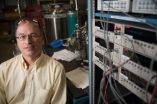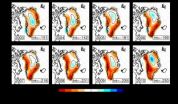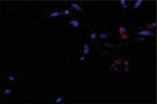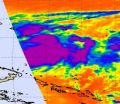(Press-News.org) LA JOLLA, CA – November 27, 2012 – Researchers at The Scripps Research Institute (TRSI) are fueling the future of cancer treatment by improving a powerful tool in disease defense: the body's immune system. By revealing a novel but widespread cell signaling process, the scientists may have found a way to manipulate an important component of the immune system into more effectively fighting disease.
The study, recently published online ahead of print by the journal Blood, shows that disabling a particular enzyme, called ItpkB, in mice improves the function of a type of immune cell called Natural Killer cells.
"This is an exciting finding because it could possibly lead to the development of drugs that improve Natural Killer cell function," said TSRI Associate Professor Karsten Sauer, PhD, who led the study. "Natural Killer cells have gained clinical interest as innovative biological therapeutics for certain cancers and also in certain infectious diseases."
The Body's 'SWAT Team'
Natural Killer cells patrol the body and detect characteristic alterations on the surface of cancer cells or virus-infected cells. Through a complicated and little understood signaling machinery—a domino effect of molecular reactions in a cell that ultimately produces a certain signal—Natural Killer cells then destroy such "stressed" cells.
Compared to other types of immune cells, Natural Killer cells kill these cells quickly. This makes Natural Killer cells important early responders of the immune system. Not surprisingly, researchers have explored engaging this "SWAT team" of the body therapeutically, particularly in blood cancers.
However, to date, the therapeutic efficacy of Natural Killer cells has been limited. "A key bottleneck is our limited understanding of signaling mechanisms that dampen Natural Killer cell function," Sauer said.
Sauer and colleagues' new research reveals crucial details of this puzzle.
A Way to Prime the Attack
The Sauer group had previously identified ItpkB as a key regulator of immune function. ItpkB acts primarily by producing IP4, a small molecule messenger that controls the functions of various other important signaling molecules. IP4 can improve or inhibit signaling depending on the cell type in which it is produced.
The new research showed that Natural Killer cells from mice lacking ItpkB show elevated signaling and function better than Natural Killer cells that have the enzyme. As a result, mice lacking ItpkB are more effective than mice expressing ItpkB in attacking cells that display characteristic surface changes of cancer cells.
"The enzyme ItpkB has unique features that facilitate its highly specific inhibition by small molecules," said Sauer. "Our findings suggest that such compounds could possibly be used to improve Natural Killer cell function therapeutically. If successful, this could overcome a bottleneck and engage the body's SWAT team to fight cancer."
INFORMATION:
In addition to Sauer, Eugene Park of Washington University School of Medicine was a co-first author of the study, "Inositol Tetrakisphosphate Limits NK Cell Effector Functions by Controlling Phosphoinositide 3-Kinase Signaling." Other authors include Sabine Siegemund, Luise Sternberg and Stephanie Rigaud of TSRI and Anthony R. French, Joseph A. Wahle, A. Helena Jonsson, Wayne M. Yokoyama and co-corresponding author Yina H. Huang of Washington University School of Medicine. For more information, see http://bloodjournal.hematologylibrary.org/content/early/2012/11/20/blood-2012-05-429241.abstract.
The research was supported by grants from the National Institutes of Health (AI070845, GM088647, AI089805 and AI007606), The Leukemia and Lymphoma Society Scholar Award 1440-11 and Deutsche Forschungsgemeinschaft fellowship SI 1547/1-1.
Scripps Research Institute study points to potential new therapies for cancer and other diseases
2012-11-28
ELSE PRESS RELEASES FROM THIS DATE:
New thermoelectric material could be an energy saver
2012-11-28
By using common materials found pretty much anywhere there is dirt, a team of Michigan State University researchers have developed a new thermoelectric material.
This is important, they said, because the vast majority of heat that is generated from, for example, a car engine, is lost through the tail pipe. It's the thermoelectric material's job to take that heat and turn it into something useful, like electricity.
The researchers, led by Donald Morelli, a professor of chemical engineering and materials science, developed the material based on natural minerals known ...
Princeton research: Embracing data 'noise' brings Greenland's complex ice melt into focus
2012-11-28
VIDEO:
Princeton University researchers developed an enhanced approach to capturing changes on the Earth's surface via satellite that could provide a more accurate account of how geographic areas change as a...
Click here for more information.
An enhanced approach to capturing changes on the Earth's surface via satellite could provide a more accurate account of how ice sheets, river basins and other geographic areas are changing as a result of natural and human factors. ...
'Fountain of youth' technique rejuvenates aging stem cells
2012-11-28
Toronto, ON (27 November, 2012) -- A new method of growing cardiac tissue is teaching old stem cells new tricks. The discovery, which transforms aged stem cells into cells that function like much younger ones, may one day enable scientists to grow cardiac patches for damaged or diseased hearts from a patient's own stem cells—no matter what age the patient—while avoiding the threat of rejection.
Stem cell therapies involving donated bone marrow stem cells run the risk of patient rejection in a portion of the population, argues Milica Radisic, Canada Research Chair in ...
How vegetables make the meal
2012-11-28
Parents may have some new motivations to serve their kids vegetables. A new Cornell University study, published in Public Health Nutrition, found that by simply serving vegetables with dinner, the main course would taste better and the preparer was perceived to be more thoughtful and attentive.
"Most parents know that vegetables are healthy, yet vegetables are served at only 23% of American dinners," said lead author Brian Wansink, PhD, the John Dyson Professor of Marketing and Consumer Behavior at Cornell University. "If parents knew that adding vegetables to the plate ...
GSA Bulletin: From Titan to Tibet
2012-11-28
Boulder, Colo., USA – GSA Bulletin articles posted online between 2 October and 21 November span locations such as the San Andreas fault, California; Tibet; Mongolia; Maine; the Owyhee River, Oregon; the Afar Rift, Ethiopia; Wyoming; Argentina; the Sinai Peninsula, Egypt; British Columbia; the southern Rocky Mountains; Scandinavia; and Saturn's largest moon, Titan. Topics include the "big crisis" in the history of life on Earth; the structural geology of Mount St. Helens; and the evolution of a piggyback basin.
GSA Bulletin articles published ahead of print are online ...
NASA's TRMM satellite confirms 2010 landslides
2012-11-28
A NASA study using TRMM satellite data revealed that the year 2010 was a particularly bad year for landslides around the world.
A recent NASA study published in the October issue of the Journal of Hydrometeorology compared satellite rain data from NASA's Tropical Rainfall Measurement Mission (TRMM) to landslides in central eastern China, Central America and the Himalayan Arc, three regions with diverse climates and topography where rainfall-triggered landslides are frequent and destructive hazards to the local populations.
The work, led by Dalia Kirschbaum, a research ...
Fast forward to the past: NASA technologists test 'game-changing' data-processing technology
2012-11-28
It's a digital world. Or is it?
NASA technologist Jonathan Pellish isn't convinced. In fact, he believes a computing technology of yesteryear could potentially revolutionize everything from autonomous rendezvous and docking to remotely correcting wavefront errors on large, deployable space telescope mirrors like those to fly on the James Webb Space Telescope.
"It's fast forward to the past," Pellish said, referring to an emerging processing technology developed by a Cambridge, Mass.-based company, Analog Devices Lyric Labs.
So convinced is he of its potential, Pellish ...
NASA sees Tropical Storm Bopha intensifying in Micronesia
2012-11-28
Tropical storm warnings are in effect in Micronesia as NASA and other satellite imagery indicates that Tropical Storm Bopha continues to intensify.
The Atmospheric Infrared Sounder (AIRS) instrument that flies aboard NASA's Aqua satellite captured an infrared image of Tropical Storm Bopha on Nov. 27 at 0241 UTC that indicated a lot of power exists in the strengthening tropical storm. The AIRS image captured the eastern half of the tropical storm and showed a large area of very cold, very high cloud tops, where temperatures colder than -63 Fahrenheit (-52 Celsius) have ...
High altitude climbers at risk for brain bleeds
2012-11-28
CHICAGO – New magnetic resonance imaging (MRI) research shows that mountain climbers who experience a certain type of high altitude sickness have traces of bleeding in the brain years after the initial incident, according to a study presented today at the annual meeting of the Radiological Society of North America (RSNA).
High altitude cerebral edema (HACE) is a severe and often fatal condition that can affect mountain climbers, hikers, skiers and travelers at high altitudes—typically above 7,000 feet, or 2,300 meters.
HACE results from swelling of brain tissue due ...
Most patients in the dark about what radiologists do
2012-11-28
CHICAGO – The role of radiologists in healthcare has long been poorly understood among the general public, but new research presented today at the annual meeting of the Radiological Society of North America (RSNA) shows that even patients who've had imaging exams in the past know little about the profession.
Researchers said the study findings highlight an opportunity for radiologists to educate the public about their role in healthcare.
"We know from previous studies that about half of the general public doesn't even know that radiologists are physicians," said Peter ...








